An Oral History of Popsicko
Santa Barbara’s ’90s Alt-Rockers Left a Legacy, Releasing Digital Single for First Time
By S.W. Lauden | July 8, 2021

There’s a parallel universe in which this article is about Popsicko’s triumphant two-night stand at the Santa Barbara Bowl. A world where this high-energy alternative-rock band takes a triumphant victory lap in front of an adoring hometown crowd after nearly three decades at the top of the charts, countless world tours, and piles of platinum records.
Given the buzz around Popsicko in the early ’90s, the above scenario seemed entirely possible. “[Popsicko] plays songs stocked with simple chords and catchy refrains that you can shout along to, yet blissfully devoid of overproduction and triteness,” Danny Gellert wrote for a Santa Barbara Independent cover story in 1995. “This is rock and roll that’s informed of every pop music phase since the British Invasion, yet reinvents itself like none of it ever happened.”
But you’ve probably already guessed that’s not how this story ends.
In reality, Keith Brown (guitar/vocals), Tim Cullen (guitar/vocals), Marko DeSantis (bass), and Mick Flowers (drums) were only together for a rocket-fueled three-year run that yielded the impressive but mostly forgotten album Off to a Bad Start. It’s the tale of a hard-working and hard-partying young band that seemed destined for success, only to have their dreams dashed when the main songwriter’s life was cut tragically short.
With some of Popsicko’s music set to be rereleased for the first time in two decades, now’s the time for the band’s story to be told.
Popsicko’s origins date back to 1991, when DeSantis stopped by the Isla Vista record store where Brown worked. The two were acquainted through the vibrant local music scene but didn’t really know each other. Brown — an L.A. transplant who was the original lead singer for Hermosa Beach hardcore heroes Pennywise — needed a drummer for his new band, Glitterbug. He asked for an introduction to Steve Sherlock, the basher from DeSantis’s high school glam band. In an endearing bit of pre-internet resourcefulness, DeSantis drew Brown a map to Sherlock’s I.V. apartment and the two went their separate ways.
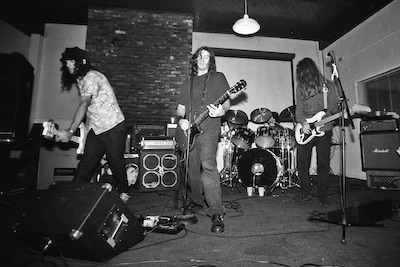
It wasn’t until a year later, when DeSantis moved back to Santa Barbara, that he and Brown started playing together. Glitterbug had already broken up by then, but Brown and Sherlock asked DeSantis to form a new project with them. A revolving door of auditions, band members, and short-lived band names ensued, but when the whirlwind of activity finally died down, Cullen and Flowers were officially in place.
The band adopted the playful name Popsicko in 1992 and started booking shows at venues like Buster’s in Goleta, the Anaconda Theater in I.V., and Alex’s Cantina downtown. They burst onto stages with blistering performances featuring poppy, punk-informed songs influenced by bands like The Replacements, Soul Asylum, Cheap Trick, and Nirvana.
“[Popsicko’s] music is part aggression, part confection — a kind of candy-apple punk. Power chords with a dusting of powdered sugar,” Jeff Gordinier wrote for the Santa Barbara News-Press in 1993.
It took a beat to establish themselves, but Popsicko soon gained a following in the same music scene that delivered stylistically diverse bands like Ugly Kid Joe, Lagwagon, Toad the Wet Sprocket, Dishwalla, and Nerf Herder onto the national stage. By 1994, it seemed certain that Popsicko would one day claim their rightful spot on that list.
The band regularly played shows from L.A. to San Francisco, sharing the stage with future headliners like Green Day and Weezer. Popsicko self-released Off to a Bad Start late that year, an album the Los Angeles Times aptly described in this capsule review: “Living up to its name and then some, these Santa Barbara pop rockers evoke memories of the late great Plimsouls, except with more (and better) guitars.”
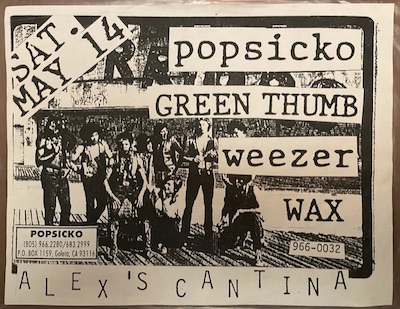
Everything was going Popsicko’s way, but there’s a reason you’ve likely never heard of them. Personal differences over drug use within the band led to an indefinite hiatus in 1995. It was terrible news for their growing army of fans up and down the state — including many notable music writers. “No doubt had Popsicko stayed together, they’d have been at the very forefront of the ’90s pop punk explosion,” said Pat DiPuccio, cofounder of Flipside fanzine.
With Popsicko on hold, Brown did some solo recording (and prepared to rerelease an alternate version of Off to a Bad Start with an L.A.-based indie label) before tragedy struck. “Keith’s one and only song as a solo artist appeared on a compilation album that Joey Cape’s My Records label released. The song was entitled ‘Suicide.’ He died in a car accident soon after, while speeding to L.A. to meet with an industry contact,” DeSantis said.
The rest of the band soldiered on, each pursuing their own post-Popsicko music careers. Cullen’s band, Summercamp, signed with Maverick Records in 1997, and he later launched a successful solo/songwriting career. Flowers played with several S.B. and L.A. bands, including the Lapdancers and the Rentals. DeSantis did stints in the Ataris and Swingin’ Utters and ran an indie record label before switching to guitar and finding success in the early 2000s with Sugarcult, as well as his side project Bad Astronaut.
Over the years, the remaining band members have done their best to keep Popsicko’s music alive. In 2007, Cullen, DeSantis, and Flowers formed the Santa Barbara supergroup the Playing Favorites with Luke Tierney (Lost Kittenz/Silver Jet) and Joey Cape (Lagwagon). “We did some shows in America and Japan and included Popsicko’s ‘Same Old Me’ in our set,” DeSantis said.
The same is true for a handful of dedicated fans around the world who play Popsicko’s music for like-minded music lovers whenever the opportunity arises. “Years later when I moved to New York, I played the album for a few friends,” said Gellert. “One became an instant fan. I gave him one of the tapes with that killer band logo on it and he made a few T-shirts from it.”
But time marches on, and by 2021 the band has become little more than a footnote to Santa Barbara’s long musical history. Which is why word of a Popsicko digital single from L.A.-based Big Stir Records was such welcome news. The July 16 release will feature two songs from Off to a Bad Start, “Nastassja” and “Gettin’ Used to You,” with the possibility for additional releases later. (Listen at bigstirrecords.com/popsicko.)
“We learned of the rich history of the Santa Barbara scene from working with Marko and some of the guys in the Brothers Steve. The reverence they have for Popsicko always felt like more than just missing a friend,” says Big Stir cofounder Christina Bulbenko. “And the record still sounds fresh, better and more immediate than most of the stuff that ruled alternative-rock radio in those days.”
I imagine every local ’90s alternative-rock scene had their own Popsicko, a band that “would’ve been, could’ve been, and should’ve been” (to quote a Popsicko lyric). That rare combination of talented musicians who had everything going for them, except the two most elusive ingredients for success: timing and luck.
“If it was 1968, these guys would be rock gods and all over the radio,” Bill Locey wrote for the L.A. Times in 1993. “The three-minute pop gem lives long and prospers with the band with the cool name, Popsicko.”
If you were there in the ’90s, enjoy this trip down memory lane. If not, get ready to discover an overlooked band from Santa Barbara’s rich musical past. Once you know Popsicko’s story, I’m confident you too will be able to imagine their music blasting from the Santa Barbara Bowl and reverberating across the town they briefly ruled.
Listen to the music at bigstirrecords.com/popsicko.
An Oral History of Popsicko
GLITTERBUG + CARDBOARD SUPERSTARS
Marko DeSantis: I had moved to L.A. in 1990. On a visit home, I ran into Keith Brown at Rockhouse Records in Isla Vista where he was working. … He had a new band called Glitterbug who were looking for a drummer, and he inquired about me connecting him to Steve Sherlock, who I had played with in my teen-era band Lost Kittenz [along with Luke Tierney of Silver Jet/the Playing Favorites, and Chris Shiflett of the Foo Fighters].
Steve Sherlock (Glitterbug/Nerf Herder): I entered the enchanted land of Glitterbug when a stranger named Keith Brown knocked on the door of my Isla Vista apartment. … Keith and I sat on my bedroom floor next to a giant pile of dirty clothes and listened to a four-track demo tape he and Dan Kern had recorded. It was rough-sounding with only guitar, bass, and vocals. I was floored by the first track, “See No Evil.” It was a 10-part, 7½-minute opus, complete with a vocal breakdown of outrageous vibrato-laden falsettos. It was super fun, turbo-charged, fairytale glitter-glam, and I was all in.

Tim Cullen: In the summer of 1991, I was in Europe busking with friends and had been away from the Santa Barbara music scene for several weeks. I had been hearing reports of this amazing new band back home called Glitterbug, an outrageous, costume-wearing, glam-rock supergroup.
Marko DeSantis: Almost a year later, I moved back to S.B. and got a call from Steve asking if I’d wanted to play bass with him and Keith in a post-Glitterbug project they were starting up called Cardboard Superstars. I did. We covered “I Wanna Destroy You” by the Soft Boys, “Roll Away the Stone” by Mott the Hoople, and did a few Glitterbug songs at first.
Chris Shiflett (Foo Fighters/Lost Kittenz): I think I jammed with an early version of Popsicko before Tim was in the band.
Marko DeSantis: Keith and I hit it off, and he asked me if I knew any good guitarists in town. I immediately thought of this guy Tim Cullen that I sort of knew through mutual pals and kinda had a reputation as a music whiz kid.
Tim Cullen: I let Marko know I was definitely interested. The next thing he said to me was that the singer, Keith Brown, was from Glitterbug. Perfect! I was not going to miss that jam. So, a few days later, we got together, and Keith was amazing. Not only was he a nice guy, but he was incredibly talented and wrote great songs. Even the cover songs he chose were awesome.
Marko DeSantis: We played a few gigs and made a four-song demo but then parted ways with [Sherlock] shortly after. I thought of another local drummer I had seen around named Mick Flowers. He was nearly impossible to get in touch with; never answered the phone, and I’m not even sure he had an answering machine yet! … He kinda reluctantly agreed to try it out.
Mick Flowers: I was already in a self-inflicted retirement after many bands and many disappointments, ultimately thinking I was better than I was. Marko (a character from my past) was at the door attempting to convince me that I was the guy for their new project. I was ambivalent, but my older brother Thom convinced me with “At least you’re going to be playing with a killer guitar player (Tim Cullen).” I relented, and this band quickly became the love of my life.
Tim Cullen: A few months later, we decided to change our sound a bit and reform under a new name. One day, Marko arrived at the studio with Mick Flowers. Mick and I also had many mutual friends but had never hung out. I was glad to finally meet and get to play together. So Mick set up his drums and we started to play, and from the first hit of the first bar of the first song, I knew he was right for the band!
Marko DeSantis: With a new drummer came a fresh start and different approach. The glammy/theatrical ([David] Bowie/Celebrity Skin/Redd Kross/Sparks) vibe of the Cardboard Superstars gave way to a grittier, more blue-collar, power pop sound informed by Keith’s heroes the Replacements and Soul Asylum and Tim’s heroes Cheap Trick, with Mick adding Dinosaur Jr. and Camper Van Beethoven, and me (three-plus years younger than the others) adding new bands like Lookout-era Green Day and Nirvana into the mix. We loved all of those bands, and our influences synergized to become our new sound.
Chris Shiflett: I had moved to L.A. in January of 1990, so by the time Popsicko was together, I was long gone but still going up to S.B. almost every weekend. Seemed like the music scene up there was thriving, lots of bands getting record deals, lots of clubs/bars to play.… I don’t think we all realized in real time just how vibrant the music scene was back in the ’80s/’90s.
Tim Cullen: Santa Barbara has always had a very diverse music scene. Unlike other cities, it’s never been known for a signature sound. Size has a lot to do with that. It’s too small to have more than one great band in any given genre. Popsicko never fit in stylistically, and we knew we never would.
INTRODUCING POPSICKO
Keith Brown (from the L.A. Times, 1993): Popsicko got going at the beginning of 1992. The band is getting to be our life, although we have to work some, usually just little things here and there. Since I didn’t make it through college, this is it for me. I just want to play music….
Marko DeSantis: We figured a new name was in order. Thinking of cool names, I noted a rave deejay at the time called Destructo and an L.A. art-punk band called Popdefect, and, of course, the word “popsicle.” I blended them and came up with Popsicko. My first suggestion was actually Ice Cream Headache, but the guys liked Popsicko better.
Keith Brown (from the L.A. Times, 1993): The description of our music is supposed to be in our name.
Tim Cullen: Keith was the primary songwriter in the band and would usually show up at rehearsal with a new idea. From there, the four of us would work out the arrangement, parts, harmonies, etc. That process usually happened pretty quickly. I also wrote songs for the band, and sometimes Keith and I would write together. In those cases, Keith usually wrote lyrics, and I wrote music. Marko also contributed to the songwriting process with lyrics, musical ideas, and song titles.
Mick Flowers: Either Keith or Tim would come up with an idea [for a song]. We would hash it out in rehearsal for hours on end…. Mostly we rehearsed in Tim’s garage, downtown, I.V., some legendary spots.
Tony Pierce (Journalist/Blogger): Popsicko used to rehearse at this space in I.V. that was near my apartment. I would hear them practice almost every day. Unlike other bands who would go through a number of tunes and covers, Popsicko played each of their songs over and over. At one point, they rotated through two-three songs repeatedly. After a while, it would get tighter and louder. And I must say, it paid off.
Marko DeSantis: We all contributed creative input and were hands-on about every detail. I handled most of the business/booking and promotion/marketing related things, but everything we did was usually a band decision: songs, set list, shows, photos, artwork, merch.
Mick Flowers: I think we did about three or four cassette EPs with Robinson Eikenberry, Rick Parker, and of course T-Flow. The Robinson sessions were recorded at our house right by the Mission, where I lived in the dining room at the time. I later heard that that house caught fire from a bass guitar case on top of the heater vent. Who knows — could be more S.B. lore.
Marko DeSantis: Most [Santa Barbara] bands back then were taking their cues from the new Seattle funk-metal and alternative-rock sounds of the day: Soundgarden, Alice in Chains, Pearl Jam, Faith No More, Red Hot Chili Peppers, Rage Against the Machine, Jane’s Addiction.
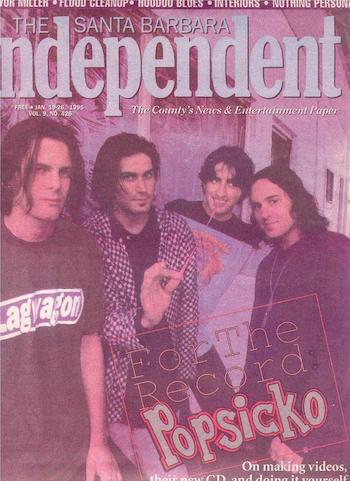
There was always a lot of thrash metal and punk bands in town too. We were kinda none of the above. Keith and I had punk roots, but Popsicko was definitely not a “punk” band by design.
Danny Gellert: The interview I did with Keith [for the Santa Barbara Independent] took place at the Ventura Concert Theater, where we went to see X. Keith had a ton of stories, but the one I still remember now had something to do with his audition for Pennywise…. The story went that he had his mom drive him to the practice space and wait in the car outside because, as he said, those guys were kind of scary and they named themselves after an evil clown.
Fletcher Dragge (Pennywise): When we first started Pennywise, Jason [Thirsk] was singing and playing bass. Then we got Keith Brown as our first singer. He was a rad guy. Super talented singer, songwriter, and guitar player. We were trying to find our way as a new band, but Keith started getting into love songs and more poppy stuff. He had a new chick and started writing songs for her, I think!
That was not the direction that we wanted to go in, so eventually we parted ways. We played some good backyard parties with Keith and even a crazy club show at Madame Wong’s. Good times for sure. I think we wrote the song “Pennywise” when he was in the band. Good kid. Tragic that he died years later in a car wreck, way before his time. May he rest in peace.
Keith Brown (from the Santa Barbara Independent, 1995): I was in a punk band, and now I’m in a pop band.
Joey Cape (Lagwagon): Popsicko’s music represents a time in my life that I remember fondly. In the early ’90s, the Santa Barbara music scene was electric. So many different styles of music, yet we all felt we were part of the same scene.
Tim Cullen: We were often described as “Cheap Trick meets The Replacements,” which I feel works as a quick and easy way to characterize Popsicko’s sound.
HITTING THE ROAD
Keith Brown (from the L.A. Times, 1993): Usually, we try to play L.A. three times, San Francisco three times, Fresno three times, and Santa Barbara three times a month.
Marko DeSantis: We got to be the local opener for touring bands like Green Day (early on their Dookie tour), Dramarama, Face to Face, Meat Puppets. We played lots of shows down in L.A. at places like Raji’s, the Gaslight, and the Whisky. We kinda fell in with this resurgent power-pop movement that was happening in L.A. at the time, which was pretty cool and felt like a new scene with bands like Baby Lemonade, Shufflepuck, and Lunchbox.
Mick Flowers: Shows were not a problem for us in S.B. All we did was play shows, and with certain contacts we played some good ones…. We also played up and down the coast — paid to play, fucked to play, blow to lay, sleep on floors, play to drink. You get the picture.
Marko DeSantis: The only show we ever did out of state was in ’95 when we drove out to Austin, Texas, to play SXSW.
Chris Shiflett: For some reason, every time I think of them live, I think of a gig they played at Raji’s down in Hollywood, not an S.B. show.
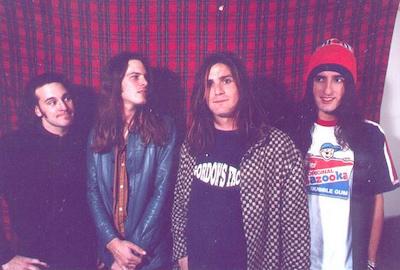
Leslie Frank (Popsicko’s lawyer): At tiny Morty’s in San Francisco, I met Popsicko. To a small midweek crowd, they played an arena-sized show, wailing and thrashing their way through catchy songwriting that lived among Badfinger, Nirvana, and Bob Dylan to my ears.
Keith Brown and company told deeply personal and relatable stories about love trouble, life trouble, and people trouble. By the time the show was over, you felt like you’d known them forever. I still have a mental snapshot of Keith doing a wild jump on that tiny stage with long hair flying.
Marko DeSantis: Bands like Nirvana, Soul Asylum, Lemonheads, Afghan Whigs, and Teenage Fanclub started to get popular, and people started to appreciate us more. By 1995, we became one of the biggest bands in town and were buzzing pretty hard in L.A. music biz chatter. Record companies, managers, and lawyers started reaching out to us, and it seemed like we were on track to go pro.
Mick Flowers: Rumors of big deals and subsequent offers of a better life don’t mean anything. We had to move forward. We did what we had to do, multiple times.
OFF TO A BAD START
Tim Cullen: We had really good momentum for a band doing it all ourselves. We’d been doing a ton of shows, getting lots of good press, playing music industry conferences. Having a record to put in people’s hands, rather than waiting for the green light from a label, felt like the right move.
Marko DeSantis: Keith borrowed some money, and we decided to do a full length record on our own, rather than wait for interested-but-still-gun-shy labels to sign us.
Tim Cullen: We made Off to a Bad Start at Sound Design, which I think was probably one of the best commercial recording studios in Santa Barbara. We worked with a producer named Adam Mitchell, an interesting guy who had written songs with a lot of artists, including Kiss.
Adam Mitchell (OTABS Producer): I met Popsicko by accident, really. I had gone to a club at Sunset and Crescent Heights in Hollywood to hear some other band. I don’t remember who, but Popsicko was also on the bill and they impressed me.
Marko DeSantis: We encountered an older guy in L.A. named Adam Mitchell, who had fronted a Canadian band in the ’60s called the Paupers (that played the Monterey Pop Festival), then he had done some solo records before achieving some success producing a few Linda Ronstadt records.

Adam Mitchell: It was their songs that caught my attention first. Kind of up, kind of modern, but very ’60s in a way also. It was a great combination, and Keith’s lyric ideas were interesting too. I remember also being impressed with Tim’s guitar playing.
Tim Cullen: Recording with Popsicko was always fun. We worked pretty quickly and didn’t overthink things.
Marko DeSantis: Me, Mick, and Tim were a bit skeptical about whether or not [Adam] was the right fit … but Keith was smitten and became fixated on the idea of working with someone who had some semblance of legit industry stripes.
Mick Flowers: To my recollection, the initial tracks were done live — very exciting!
Mike Randle (Baby Lemonade/Love): I was hanging around the guys from Popsicko in Isla Vista when they were in pre-production rehearsals, as well as a few times when they were in the studio with the producer recording tracks for Off to a Bad Start. When they were working on “Some Mother’s Son” (my favorite cut from that record), I remember how crisp and crunchy Keith Brown’s Fender Telecaster Deluxe sounded going into his Matchless amplifier. The band really clicked on that song.
Adam Mitchell: As it turned out, we ended up with lots of great songs on the record, but two I would personally single out are “Nastassja” and “Starless.” Good melodies, great energy. And Keith’s vocals really jumped off the record.
Mick Flowers: I think the fact that we’re still talking about the record 85 years later means it had a decent reception.
INDEFINITE HIATUS
Marko DeSantis: Towards the end, the band kinda fractured into two camps: Mick and Keith, and Tim and I. We all drank and partied a lot in those days, but Tim and I never got into doing drugs. Mick would dabble on occasion, but Keith was never one to embrace moderation and unfortunately got strung out. This would ultimately become Keith and the band’s undoing.
There was even a time where we staged a makeshift intervention and froze all Popsicko-related activity in hopes that Keith would get help and clean up. Keith felt insulted and betrayed but hopefully knew deep down that it was an act of tough love. Popsicko was indefinitely on hold.
Tim Cullen: Personally, I didn’t consider the band to have officially broken up until we lost Keith. It had only been a couple of months since we’d last played, and it seemed entirely possible that we could’ve met up, talked things through, and gotten our act together.

Marko DeSantis: After our eventual hiatus, Keith moved forward to take a deal by an independent label Smart/Unity that wanted to rerelease Off to a Bad Start; he removed the two songs Tim sang lead on (“Same Old Me” and “No Better Time”) and added “Ashtray Mouth.” He didn’t really consult us about that, but to be fair, he had paid for everything, so we couldn’t really argue about his desire to take a chance to recover his investment. Still though, the rereleased version sounded great but was sad all around. Its street date was in late November; Keith died on November 7, about two weeks before it was rereleased.
Mick Flowers: That was a horrible time and a terrible loss.
Adam Mitchell: The tragedy of it all, of course, is that right when Keith died, Off to a Bad Start was just beginning to gain traction, climbing the charts at college radio, and, belying the title, looking like it had a bright future ahead of it.
Mick Flowers: I still listen with teary-eyed nostalgia. I’m very proud of the end result. Honestly, recording is where we shined.
Danny Gellert: And Keith dying, I mean, that’s not supposed to happen in your twenties, is it? I still think about that all the time. About his music. About the way he was the quietest guy but could make everyone laugh the loudest. And he could sing. He was one of those guys who just knew how to sing what you were feeling.
Tony Pierce: I cannot listen to that album. It makes me so very sad. Isla Vista was the home of rock music for a few years. The Mecca. The Bethlehem. And Keith was the biggest rock star of Isla Vista. His clothes, his hair, his makeup, even his gear was top notch and professional. It breaks my heart that he wasn’t able to make it here with us.
Tim Cullen: As Keith’s friend and fan, I can only imagine what extraordinary things he would have gone on to accomplish in music and life. Keith was an incredibly gifted, kind-hearted, beautiful soul. I was fortunate to have known him, and I’m grateful for the time we spent together. I will miss him forever.
LOOKING BACK
Marko DeSantis: I’ve made many records since Off to a Bad Start, but that one will always occupy a sacred space in my rock ’n’ roll heart. It’s quite possibly my favorite record I’ve ever been part of. I love all the songs; they’re all really good, have aged well, and stood the test of time. “Nastassja,” “Starless,” “Same Old Me,” “Gettin’ Used to You,” and “Ashtray Mouth” are the ones I usually play for people when I tell them about us.
Chris Shiflett: My favorite Popsicko song was always “Same Old Me.” Timmy is such a great songwriter, and that one still holds up.
Danny Gellert: I still listen to Off to a Bad Start. The guitar riff in “I Don’t Need You” is crunchy AF and one of my all-time favorites.
Mick Flowers: My favorite song was “Gettin’ Used to You.” Very fitting of the learning process we were all going through. I’ve always loved “Same Old Me.” It’s been a consummate hit in my mind ever since I first played it…. “To Would Have Beens” is a timeless classic. Lore has it that Keith wrote it at 16 years old.
Mike Randle: When I hear “emo” music on the radio these days, I’m reminded how Off to a Bad Start was ahead of its time.
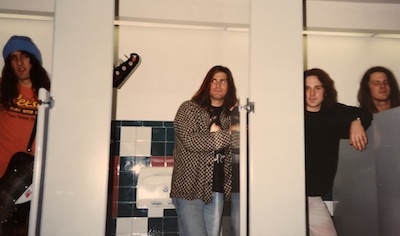
Steve Sherlock: “Draggin’ Me Down” is a perfect, high-energy power-pop song. “To Would Have Beens” is my favorite Popsicko song. It’s pure Keith Brown … raw and sincere.
Adam Mitchell: Some things are just not meant to be, I guess. What a shame. I really think they might have gone somewhere.
Tim Cullen: I don’t recall the last time I listened to Off to a Bad Start as an album, but there are a few songs I still really enjoy hearing. I think “Starless” and “Gettin’ Used to You” are two of Keith’s best songs. I also like “Nastassja,” which was often a show opener and brings back so many fond memories of playing live together.
Mick Flowers: With all my heart, thanks for including me in your retrospective of a band that woulda, coulda, shoulda been a success.
Marko DeSantis: Popsicko will forever be my proverbial one that got away…. Keith had the charisma, the intellect, the voice, the fury, the face, the attitude, the authenticity. Keith had that “undefinable something” that rock stars have; just broken and flawed enough, with the right mix of raw talent and renegade spirit.
S. W. Lauden is the co-editor of Go All The Way: A Literary Appreciation of Power Pop and the sequel, Go Further. He is author of the Greg Salem punk rock PI series including Bad Citizen Corporation, Grizzly Season, and Hang Time. His power-pop-themed crime novelettes include That’ll Be The Day: A Power Pop Heist and Good Girls Don’t. S. W. Lauden is the pen name of Steve Coulter, drummer from Ridel High, Tsar, and the Brothers Steve.




You must be logged in to post a comment.